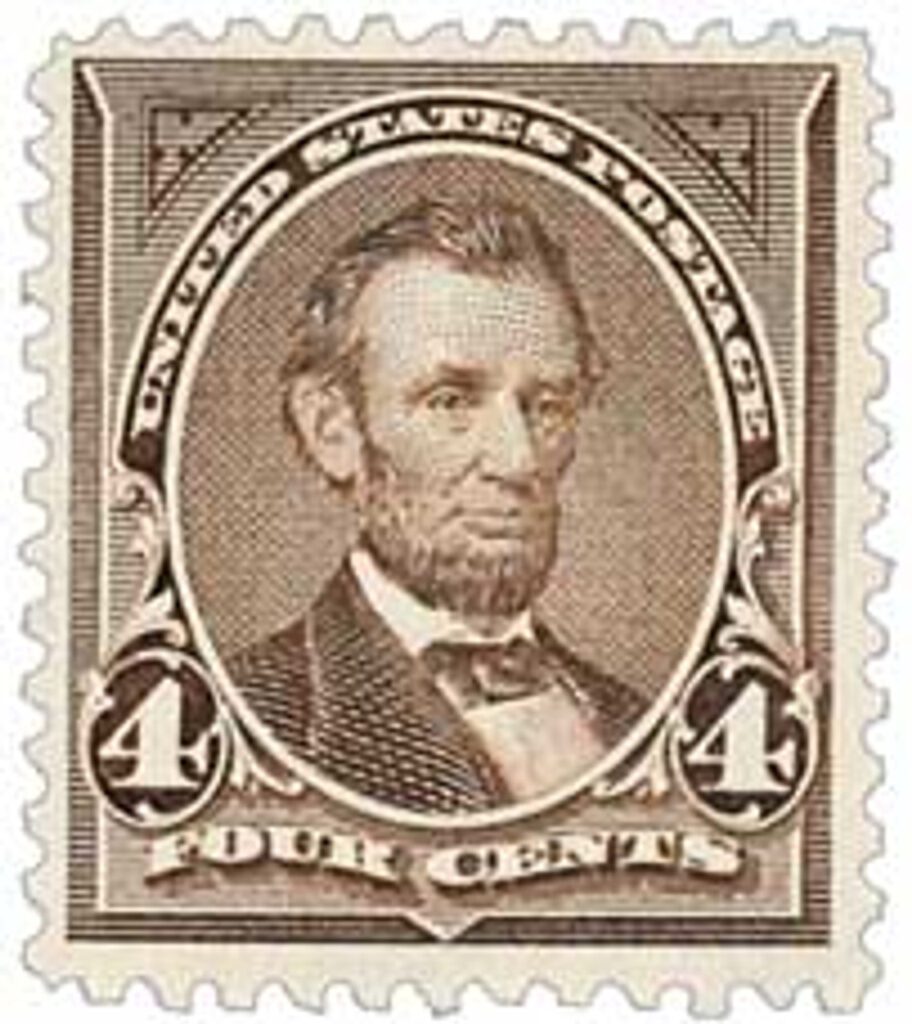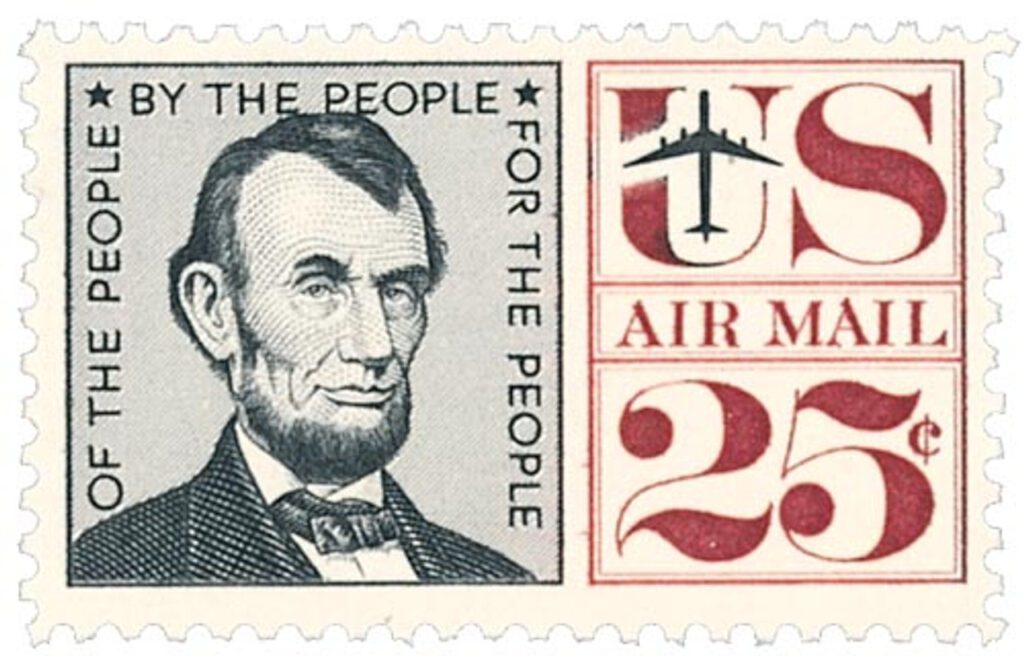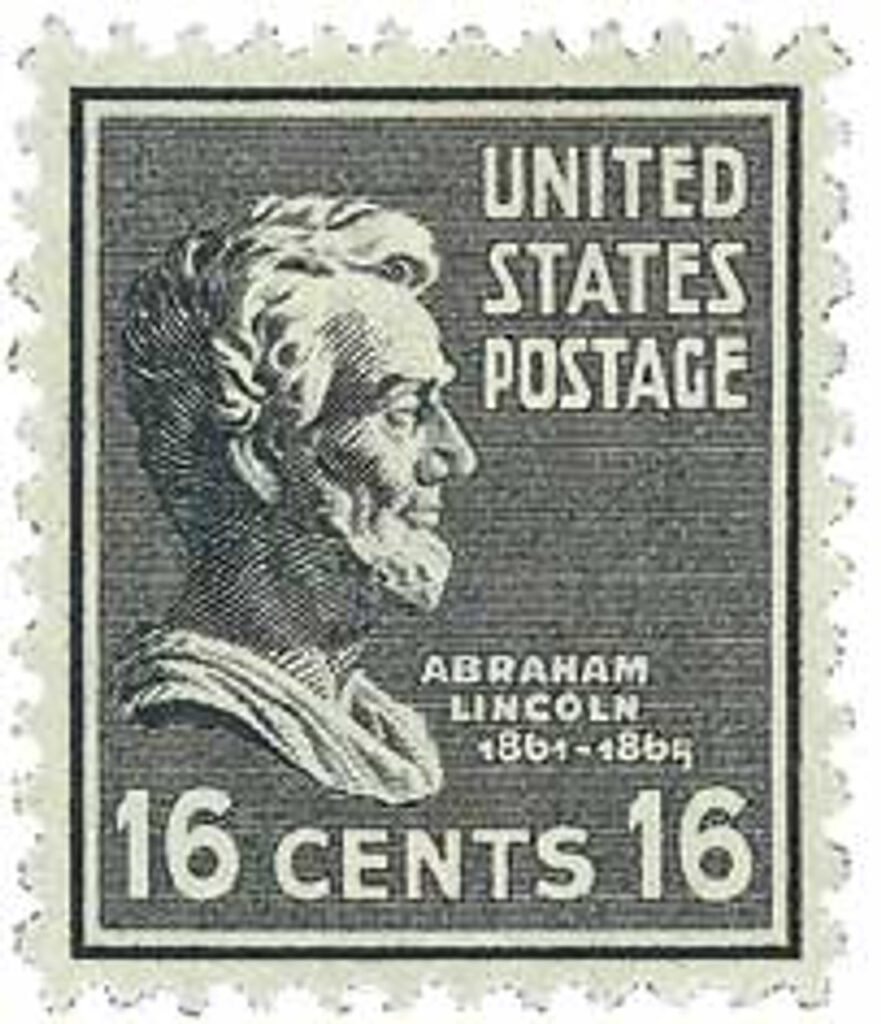Abraham Lincoln was born in a log cabin near Hodgenville, Kentucky, on February 12, 1809.
Lincoln was the second child of Thomas and Nancy Lincoln. The Lincoln’s lived in a one-room log cabin on Sinking Spring Farm in Hardin County, Kentucky. Seven years later, they lost their farm due to a faulty real estate title and moved to Perry County (now Spencer County), Indiana. Lincoln’s mother died of milk sickness when he was nine and his father married Sarah Bush Johnston.

Lincoln received about 18 months of formal education from various teachers, but was an avid reader and mostly self-taught. A tall boy, he helped his father as a rail-splitter and was also a talented wrestler. He refused to hunt or fish because he could not bring himself to kill animals.
In 1830, the Lincolns relocated again to Macon County, Illinois. The following year, 22-year-old Abraham left his family to canoe down the Sangamon River to New Salem. There he was hired by a local businessman to deliver goods by flatboat to New Orleans via the Sangamon, Illinois, and Mississippi Rivers. After witnessing the horrors of slavery first-hand, he returned home.

In 1832, Lincoln began his political career, running for the Illinois General Assembly. He was well-known for his stories and anecdotes, but lacked a formal education, powerful friends, and money and finished eighth in the election. Lincoln went on to serve as New Salem’s postmaster and county surveyor. Two years later, Lincoln was elected to the state legislature as a Whig.
After deciding to become a lawyer, Lincoln began teaching himself from law books. He was admitted to the bar in 1837 and moved to Springfield, Illinois, to practice under John T. Stuart (a cousin of his future wife, Mary Todd). Lincoln quickly built a positive reputation, especially for his cross-examinations and closing arguments.
At the same time, Lincoln also served four consecutive terms in the Illinois House of Representatives as a member of the Whig party. Lincoln supported economic modernization in banking, railroads, and internal improvements, urbanization, and protective tariffs. In this office, he was known for his “free soil” position, standing against both slavery and abolitionism.
Riding the circuit twice a year for ten weeks at a time, Lincoln appeared in county seats throughout the mid-state region. He worked on several transportation cases, especially those involving river barges under the new railroad bridges. He was particularly interested in these cases due to his days as a riverboat navigator. In 1849, he got a patent for a “device to buoy vessels over shoals or ballast tanks.” Lincoln is the only US president to hold a patent. In Lincoln’s years as a lawyer, he appeared before the Illinois Supreme Court 175 times, 51 of those as the sole counsel, and 31 that were decided in his favor.
Lincoln returned to politics in 1854 to oppose the Kansas-Nebraska Act, which repealed the Missouri Compromise that had restricted slavery. Illinois Senator Stephen A. Douglas included popular sovereignty in the act, which gave people the right to determine whether or not to allow slavery in their territory. In response to this, Lincoln delivered his “Peoria Speech,” which claimed the Kansas Act “declared indifference.”
Three years later, the Illinois Republican Party nominated Lincoln for the US Senate, leading to his famous “House Divided” speech. In 1858, Lincoln and Senator Stephen Douglas held a series of seven debates that are among the most famous in US history. Although Lincoln lost the seat to Douglas, the debates brought him national attention that made him a top runner for the upcoming presidential election.
Following Lincoln’s well-received Cooper Union Address in New York City, the Illinois Republican party formed a team to promote his campaign for president. They embellished his childhood pioneer days nicknaming him “The Rail Candidate.” Lincoln was elected the 16th president on November 6, 1860. Lincoln won 180 electoral votes, compared to the 123 of all his opponents combined. The following month, South Carolina became the first state to secede from the Union. By February, six more states followed and declared themselves the Confederate States of America (CSA). Lincoln attempted to compromise, but the CSA refused.
In his Inaugural Address, Lincoln said to the South, “We are not enemies, but friends. We must not be enemies… The mystic chords of memory, stretching from every battlefield, and patriot grave, to every living heart and hearthstone, all over this broad land, will yet swell the chorus of the Union, when again touched, as surely they will be, by the better angels of our nature.”
Less than two months after Lincoln’s address, the commander of Fort Sumter in South Carolina requested provisions. The Confederates saw this as an act of war and on April 12, 1861, fired on Union troops at Fort Sumter, officially beginning the Civil War. Lincoln then called upon 75,000 troops to recapture forts, protect Washington, DC, and “preserve the Union.” This forced the states to choose sides, leading North Carolina, Tennessee, Arkansas, and Virginia to secede, with Richmond, Virginia, becoming the new Confederate capital.
Lincoln called upon his presidential war powers to create a blockade on the South, distribute funds without Congress’s permission, and suspend habeas corpus – arresting and imprisoning thousands of Confederate sympathizers without a warrant. He faced criticism from all sides, with war opponents unhappy that he would not compromise on the slavery issue and Radical Republicans believing he was taking too long to abolish slavery. In addition to the stress of the war, Lincoln was also faced with the death of his young son Willie.
Although Lincoln had little experience with military tactics, he studied books from the Library of Congress and field reports and kept a close watch on all military endeavors. His primary goals were to protect the capital and win the war as quickly as possible. Lincoln understood the importance of taking control of strategic points and defeating the enemy, rather than just capturing territory.
Following the Union victory at the Battle of Antietam in September 1862, Lincoln issued his Emancipation Proclamation, which he had written months earlier. The proclamation, which went into effect the following January, freed all enslaved people in the Confederate States of America and permitted African Americans to join the Union Army. However, the Confederates did not recognize his authority so few slaves were freed at first.
The next major Union victory was not until almost a year later. The Battle of Gettysburg, although a success for the Union, was one of the bloodiest battles of the war. So many Union soldiers were killed, a special cemetery was created and Lincoln was invited to speak at its dedication. He saw this as his chance to rally public support for the war by defending his actions, explaining why the war had to continue, and that because of these casualties the “government of the people, by the people, for the people, shall not perish from the earth.” His Gettysburg Address has become one of the most famous speeches in history.
To give Lincoln a broader appeal in the election of 1864, the Republican Party selected Andrew Johnson, a War Democrat from Tennessee, as his running mate. While many Republicans feared he might still lose the election, Lincoln signed a pledge promising that if he lost, he would beat the Confederacy before leaving the White House. Ultimately, Lincoln won the election in a landslide, winning all but three states.
Four years of fighting reached an end on April 9, 1865, when Confederate General Robert E. Lee surrendered to Grant at the Appomattox Court House in Virginia. With the war over, Lincoln finally felt relief and was prepared to lead the United States through Reconstruction.
While he is largely remembered as the Civil War president, Lincoln made progress in other areas. His signature led to the establishment of agricultural colleges in each state, the construction of the First Transcontinental Railroad, the creation of the first US income tax, a system of national banks, the Department of Agriculture, the establishment of Thanksgiving as a national holiday, and the creation of the Medal of Honor.

Then, on April 14, 1865, while attending the play Our American Cousin at Ford’s Theater, well-known actor and Confederate spy John Wilkes Booth snuck up behind the unprotected president and shot him in the head. Lincoln was taken to the Petersen House across the street, where he remained in a coma for nine hours. He was the first US president ever to be assassinated.
Click here for LOTS more Lincoln stamps, coins, and covers. Tip – Did you know you can narrow the results by selecting the category you want from the list on the left-hand side?

| FREE printable This Day in History album pages Download a PDF of today’s article. Get a binder or other supplies to create your This Day in History album. |
Discover what else happened on This Day in History.
















Lincoln was was underappreciated in his own time, but has been recognized in history as a truly great President. It has been said that because of his background, his looks, and his manner of speaking, he couldn’t be elected in modern times. But people forget that he was barely elected in his own time. In the election of 1960, he won the Presidency with 180 electoral votes out of 303 (59%) but only 39.8% of the popular vote. Virtually all of his votes came in the northern and western states, because he wasn’t even on the ballot in the southern states.
Lincoln received the most popular votes among the four candidates that ran in 1860 (Lincoln, Douglas, John C. Breckenridge, and John Bell). The Democrats had split into two parties with the northern wing nominating Douglas while the southern one put up Breckenridge of Kentucky. Bell from Tennessee was the nominee of a rump remnant of the old Whig Party that called themselves the Constitutional Union Party. In addition, while it was true that probably not a single slave was freed on January 1, 1863 when the Emancipation Proclamation went into effect in only those portions of the nation still under Confederate control, as Union forces went on to take over more and more of that territory it did serve to liberate slaves in it.
In the long time I have followed this running chronicle, I have never observed slanted reporting. BUT, here you chose to omit that Lincoln left national politics to fight in the Mexican/American War. Seems he did not oppose mistreatment of Mexicans like he did the Negro. AND to say Lincoln did not chose to challenge the Confederacy ignores the fact that he sent a relief ship to Fort Sumter knowing it would cause open warfare. He was warned.
I presented this “day in history” information to others in my stamp club meeting this month and advised that they could sign up to receive them on line. It is a nice educational tool to have when discussing stamps with potential young philatelic collectors. The more interesting you can make a subject, the more likely they will get involved as a collector, in my opinion. Thanks Mystic for taking the time to promote stamp collecting.
It has always seemed to me that the basic Lincoln has been overlooked because of the struggle to end slavery. If there would be one word that described the essential Lincoln it would be unity, unity of that young nation. As the summary states Lincoln worked on flatboats on the Mississippi and there he saw the necessary unity from North to the city of New Orleans for the American economy. Lincoln was in Washington at a time when we were digesting the fruits of manifest destiny and the Mexican War the nation extending from the Atlantic to the Pacific. That Lincoln was a Union, unity man should be foundation of his policies. Disunity was not in Lincoln’s dictionary. Dr. James J. Cooke, Prof. Emeritus of History (U. of Miss.)
Correction: Lee did not surrender at THE Appomattox Court House. He surrendered at the McLean House located in Appomatox Court House village.
Too bad we don’t have someone with the strength and courage of Lincoln for president today.
Feel the Bern, Martha!
We most certainly have a man of strength/courage — with all he has accomplished which includes saving us from another great depression and a complete collapse of the worldwide economic system (with no help at all from the GOP) — history will place Obama next to Abe, FDR, Washington, Adams and Jefferson as one the greatest Presidents ever. With Hillary next up, America just gets better and better.
On this same day in history, February 12, 1809, Charles Darwin was born. Two great men born on the same day!
Happy Birthday Abe! Being an avid coin collector (over 65 yrs now!) and “all things” Lincoln fan, I greatly appreciate and treasure this Lincoln tribute. In just a few words, (as always) you have captured the essence of Lincoln’s life on this auspicious day. And your invitation to click on to view your vast inventory of stamp and coin selections was memorable. Thanks Mystic! And many happy returns to you, Abe!
Many happy returns Dave ??! Many happy returns???!!!!!!? Do you realize Abraham Lincoln is long dead Dave !!?????
Thank you Mystic for the history, and thank you President Lincoln for being leader needed at that time to preserve the union. Visiting the Lincoln Memorial in DC is a must for all. I stood there and imagined having a conversation with this great man from humble beginnings.
Happy Birthday Honest Abe!!!! 🙂 Something forgot to put one more stamp Scott #1282.
Oops, make that 1860. If Lincoln had run for President in 1960, he would have been 151 years old! Another note about Lincoln’s electoral successes. In 1864, Lincoln was elected with 212 electoral votes out of 233, but only 55% of the popular vote. I say “only”, because his opponent, ex-general George McClellan ran on the platform of the Democratic Party that called for a negotiated settlement with the Confederate states which would have meant that the Union would have remained divided. Of course, in 1864, the seceded states of the South did not vote, so again all of Lincoln’s votes came from the loyal Union states of the North and West. Several Presidential candidates since then received more that 55% of the popular vote. If Lincoln had lived to serve out his second term, he would have faced huge post-war problems, but Reconstruction would have been very different as would have been the subsequent history of the United States. But that gets into the realm of speculation.
For the greater good Lincoln was a hero for that!
Happy Birthday, Mr. Lincoln. RIP, sir.